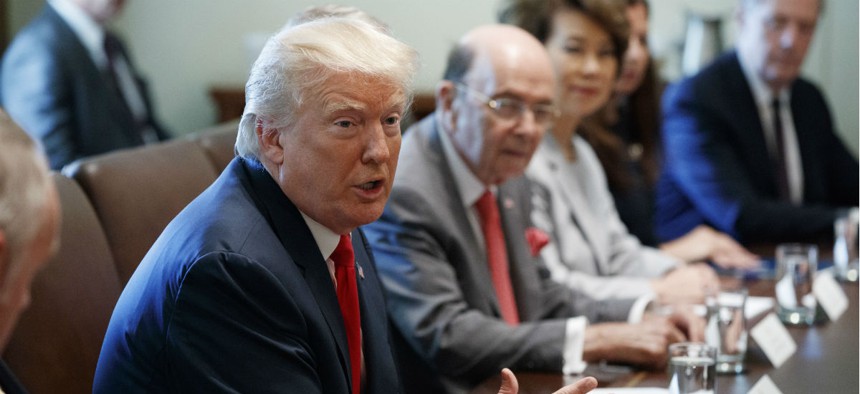How Trump Can Successfully Reorganize the Government
If the White House turns implementation over to "careerists" at OMB, "it will never happen," former personnel director says.
To successfully implement its plan to reorganize government, the Trump administration should empower federal leaders and agencies, former personnel and management officials said at a panel discussion Tuesday.
Speaking at the Washington headquarters of the Heritage Foundation, a conservative think tank, the former Republican leaders were supportive of Trump’s executive order to rebuild government “starting from scratch” and gathered to offer advice on how the administration can accomplish its goals most effectively. Trump has tapped several Heritage alumni to serve in his administration, including Office of Management and Budget Deputy Director Russ Vought.
The administration will need a disciplined focus not just on the ideas, but on how to see them through, panelists said. Donald Devine, who led the Office of Personnel Management during President Reagan’s first term, said Trump should delegate authority directly to political appointees at the agency level.
“If you just turn it over to the careerists at OMB, it will go on for a year, two years,” Devine said. “It will come out at the end with some halfway done thing. It will never happen.”
Agencies have already provided OMB with high-level plans on how to rebuild themselves and cut their workforces. Final proposals, after OMB provides feedback on the initial drafts, are due Sept. 30.
Robert Shea, who served as OMB’s associate director for administration and government performance in the George W. Bush administration, said top officials must commit themselves to crafting and implementing those plans. He called the reorganization necessary because the tasks assigned to the federal government have grown too large and it “can’t possibly accomplish all we ask it to do.” Typically, he noted, such efforts are undertaken after a crisis, such as the Sept. 11th terror attacks, which led to the creation of the Homeland Security Department. In this case, he said, the Trump administration must dedicate the time necessary to engage all stakeholders and get suggestions across the finish line.
That will require “leadership that gets it, that is willing to invest the time, the energy, and intellectual and political capital to get these kinds of initiatives done,” Shea said, “because at lower levels you’re just not going to have the juice to get it done.”
Getting buy-in from the top will help “clear out a lot of the bureaucracy underbrush,” he explained. Those individuals can help engage stakeholders in the legislative and executive branches, as well as those outside government. They must be perseverant, he said, and pledge to follow through on implementation details.
“Just because you create the Homeland Security Department, it doesn’t make the homeland more secure,” Shea cited as an example.
Convincing Congress to go along with their ideas could prove to be the most difficult task for Trump, OMB Director Mulvaney and agency leaders, the panelists said. With all the different committees with jurisdiction over various agencies, finding universal agreement is a delicate proposition. Shea predicted that when the administration formally submits its reform ideas to Congress early next year through its fiscal 2019 budget blueprint it will include “some of the most ambitious reorganization plans in a long, long time.” He suggested the administration propose a process similar to that of the Defense Department’s Base Realignment and Closure Commission, which provided lawmakers with political cover for potentially unpopular decisions by requiring them to vote on recommendations en masse.
“If Congress is not prepared to undertake the legislation required to accomplish these reorganizations they will not happen,” Shea said, “and I don’t think they are right now. That’s a real gap in the initiative to reorganize the government.”
Devine, who helped oversee a 100,000-employee reduction in the civilian workforce during his tenure at OPM, called his reforms—as well as those Shea helped institute through the Pentagon’s National Security Personnel System—a “miracle.” He lamented that many of those changes, including NSPS, have since been reversed.
“Nothing has changed very much,” he said. Getting the right political appointees in place across government, he added, and having a Congress that “will give you a little room to operate for a while” will be the two keys for Trump’s reorganization effort.
Shea added that it would be “essential to your progress and ultimate success” to engage with the civil service. That can occur directly or through their unions, though he cautioned that in his experience the labor groups are “unwilling to even take a seat at the table” with Republican administrations.




